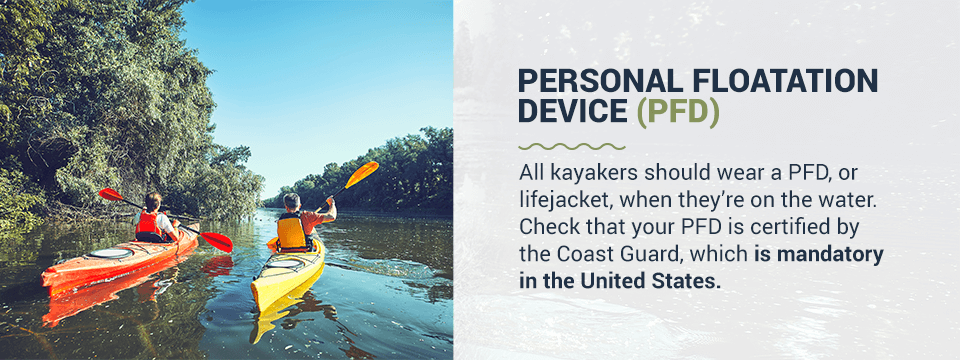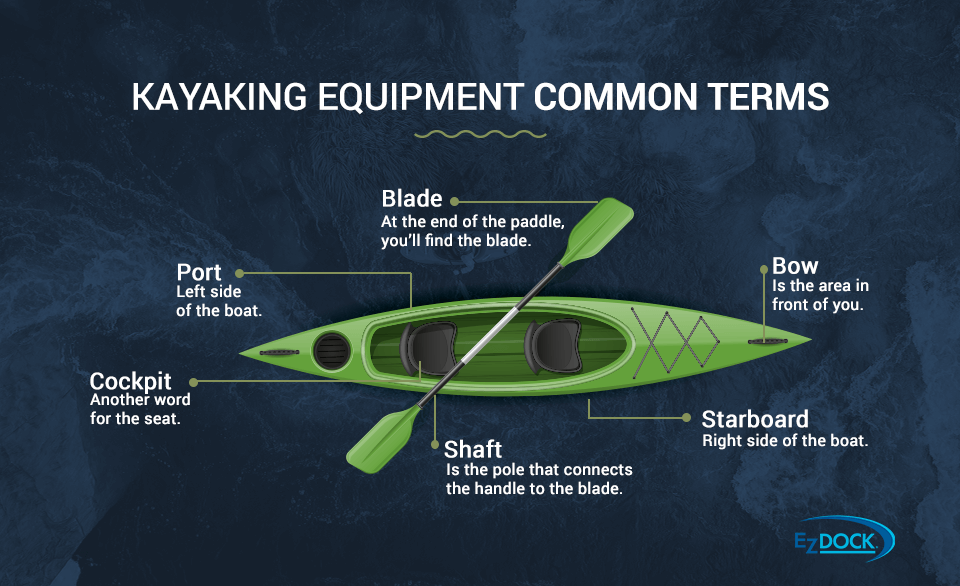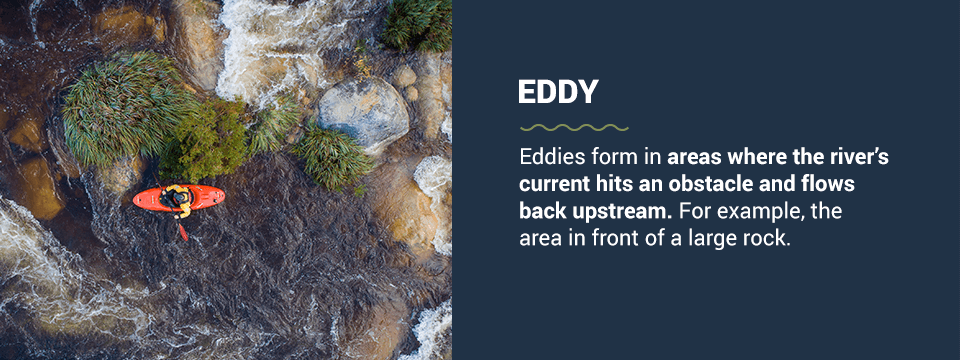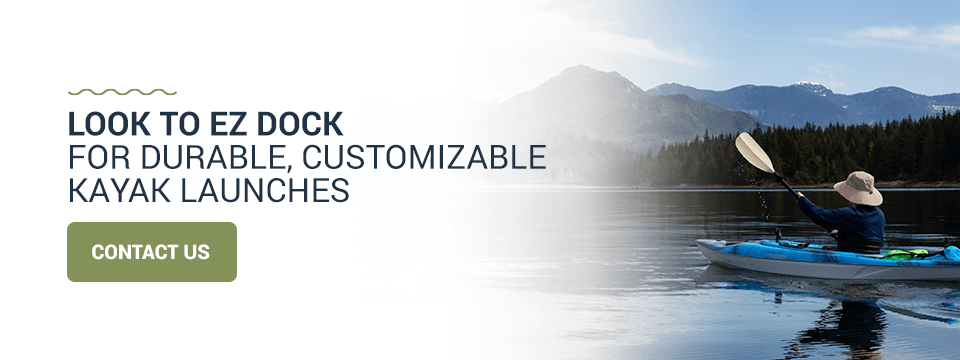Filters
Common Kayaking Terms You Should Know
When you take your kayak out for a spin, you probably don’t think twice about the boat’s hull or cockpit. Instead, you take a seat, grab the paddle and head out onto the water for a pleasant afternoon. But although the sport can be pretty straightforward, you should still take the time to learn about various kayaking terms and vocabulary.
This way, whether you’re a beginner or an expert, you’ll know how to maintain and use your kayak the right way. A little bit of knowledge can help you make the most out of your experience. Plus, you’ll be able to help everyone else in your crew become more comfortable on the water.
Read the full article or jump to a specific section:
Check out common kayaking terms you should know.
Kayaking Equipment Common Terms
Even if you’ve never kayaked before, you know that you need a kayak and a paddle. However, both components have various features. It’s smart to understand how your equipment works so you can kayak safely and responsibly.
Here are 27 kayaking terms to help you better understand your boat and gear.
- Back band: This band is located behind the seat and helps the kayaker sit upright while they kayak. It provides lower back support, too. Feel free to adjust the back band to make your seated position feel more comfortable.
- Bent shaft paddle: If you have wrist issues, you may benefit from a bent shaft paddle, which is designed to keep the kayaker’s hands in a neutral position while they steer.
- Blade: Every paddle has a few different parts. At the end of the paddle, you’ll find the blade. This wide, flat section is what you insert into the water to propel the boat.
- Bow: Imagine that you’re sitting in a kayak. Because you’re in the middle, you have one section in front of you and one section behind you — and the bow is the area in front of you. It points toward the direction you’re going.
- Bow lines: These are straps you can use to secure the bow to your vehicle or a dock.
- Bulkhead: This is a protective, supportive wall inside the kayak. It’s made from plastic or foam, which helps keep water out of the boat should your kayak flip. Thanks to the bulkhead, your boat will be easier to rescue and your items stored inside won’t become damaged.
- Carabiner: If you’ve ever gone hiking or backpacking, you may have used carabiners. These are metal hooks that open and close with a gate. While they have various applications, kayakers mainly use them to clip their belongings to their boat’s storage compartment.
- Carry handles: Most kayaks feature carry handles located in the front or rear that you can use to lift the boat.
- Coaming: When you use a sit-in kayak, your seat has an outer edge called the coaming.
- Cockpit: This is another word for the area where you sit in the kayak.
- Deck: Each kayak has a top and a bottom, and the top is known as the deck.
- Deck bungees: A kayak’s bow and stern often come with deck bungees, which are flexible cords you can use to secure various items.
- Dry bag: Many kayakers pack their phones, snacks and other belongings in waterproof dry bags so they don’t get water damage.
- Foot braces: When you sit in a kayak, you extend your legs outward so they’re horizontal to the ground. Here’s where you’ll find the foot braces. If your boat has a rudder, you typically use the foot braces to control that component.
- Hatch: At the back of your kayak, you’ll likely find a hatch, which you can open to find a storage compartment.
- Hull: The hull is the bottom of your kayak.
- Keel: When you look at the hull, you’ll find a ridge toward the back called the keel.
- Port: Many expert boaters refer to the left side of a boat as port.
- Personal floatation device (PFD): All kayakers should wear a PFD, or lifejacket, when they’re on the water. Check that your PFD is certified by the Coast Guard, which is mandatory in the United States.
- Rudder: Your kayak might have a drop-down or flip-down fin at the rear. This is called the rudder, and it can swivel to steer the kayak.
- Scupper holes: These are small holes situated in the front and back that drain water that makes its way inside the boat.
- Shaft: All paddles have shafts, which is the pole that connects the handle to the blade.
- Spray skirt: If you don’t want water in your kayak’s cockpit, you can wear what’s called a spray skirt. It’s a piece of clothing you secure around your torso that extends outward to cover the openings around your seat. These are best for times when the water is cold and choppy.
- Starboard: While port refers to the left side of the boat, your right side is known as starboard.
- Stern: When you’re sitting in a kayak, you have a section behind you, known as the stern. It points to where your kayak was just positioned in the water. Underneath the stern, you’ll find the keel.
- Thigh braces: These are pads on the inner sides of the cockpit where you can rest your thighs.
- Trim: All kayaks have a trim that controls the boat’s movement in the water. Usually, trims position the stern a bit lower in the water. However, the boat is entirely level everywhere else.
Kayaking Techniques Common Terms
There are several kayaking terms that refer to how you operate the kayak and the paddle. To become a more seasoned kayaker, you should know a few phrases so you can improve your technique. Plus, you can show off your new skills to your family and friends.
Take a look at 28 kayaking vocabulary and phrases about water classifications, paddling techniques and more.
- Backstroke: A backstroke is when you paddle backward.
- Bearing: This refers to the direction you’re currently headed, which is why you might say you have to “get your bearings.”
- Bow draw: This is a stroke you make at the bow to turn the boat in a specific direction.
- Brace stroke: If you feel like you’re about to capsize in your kayak, you can perform a brace stroke. Essentially, you position your paddle horizontally across your body so the blades are flat above the water. Then, you lean to the side where the boat is tilting to slap the paddle against the water, pushing your knee against the cockpit to move the kayak into an upright position.
- Class A rapids: This refers to completely still water, as you’d find in a lake or pond.
- Class I rapids: This is a classification of white water that’s slightly more turbulent than class A rapids. If you’re in class I waters, you’ll likely have to navigate a few obstacles, like sandbanks or rocks. These are well-suited for beginners.
- Class II rapids: Compared to class A and class I waters, class II rapids are a little faster. Kayakers may encounter small waves that rock the boat and typically have to navigate around bends in the waterway. These routes are best for intermediate kayakers.
- Class III rapids: While class III rapids aren’t the most challenging waters you’ll encounter, you must have the expertise to navigate them successfully. There are quick waters, narrow passageways and other intense obstacles that force you to think quickly. These rapids require preparation beforehand.
- Class IV rapids: Like class III rapids, class IV waters involve fast currents that require extensive knowledge and preparation to navigate properly. These rapids feature rough water conditions. If your kayak doesn’t have any floatation bags, you shouldn’t go in class IV rapids.
- Class V rapids: Class V rapids best suited expert kayakers who intimately know whitewater conditions. Here, you’ll find steep drop-offs, tight corners and various additional hurdles. Unless you have a kayak specifically designed for class V routes or higher, as well as extensive expertise, you’ll put yourself at risk.
- Class VI rapids: These are the most intense and challenging rapids you’ll encounter. Only professional, Olympic-level kayakers should attempt them. They require extensive preparation and constant monitoring to ensure safety throughout the course.
- Downstream: If you kayak in a river, you’ll note that the water flows in one direction, called the downstream.
- Downstream V: A downstream V is the open, obstacle-free area where you can either enter the river or continue on downstream.
- Eddy: Eddies form in areas where the river’s current hits an obstacle and flows back upstream. For example, the area in front of a large rock. If you find one on the side of the river, you can rest there
- Forward stroke: This is the move you do when you propel yourself forward with the paddle.
- Kayak roll: If you ever capsize your kayak, you should know how to put the boat back into position. A kayak roll, also known as an Eskimo roll, is a move you can do to right the kayak underwater with your body or paddle. Basically, you lift your torso upward, moving your hips quickly to the right. Then, you use the paddle to push yourself back up to the surface.
- Open water: All bodies of water that don’t have a shoreline on either side are considered open water. These can be lakes, ponds and oceans. Unless you’re experienced with open water kayaking, you may prefer to stick with rivers, which provide simpler routes.
- Portage: Taken from the French word for “carry,” kayakers portage their boats whenever they carry their boats across land or water as a means of transportation.
- Rapid: A rapid occurs when sections in the river move faster than normal. That happens due to changes in the gradient. These areas can range in sizes, so only seasoned kayakers should attempt to navigate intense rapids.
- Reading water: When you navigate rapids at high classifications, you’ll need to read the water to ensure you know the route’s conditions.
- Riffles: If you hear someone point out “riffles” in class I water, they’re talking about the small rapids that often form across shallow parts in the water.
- River left and river right: As you navigate downstream in a river, you’ll often have to move river left or river right, which is simply going toward the left or right side of the waterway.
- Sculling draw: Sometimes, you’ll need to move your kayak sideways in the water. That’s when you’ll use a trick called the sculling draw. It’s a figure-eight stroke you perform with one end of the paddle.
- Side draw: A side draw can be used to move the kayak toward a dock or shoreline so you can leave the water. After you position your paddle on the side you want to move toward, you’ll extend the paddle outward in the water, drawing the paddle back toward you. This action pulls the kayak in the intended direction.
- Sweep stroke: With a sweep stroke, you can turn your kayak in either direction. Position the paddle in the water next to you. Then, pull the paddle in an arch back toward the stern. This sweeping motion can be used on either side of the boat to turn left or right.
- Upstream: This refers to the direction opposite of the downstream. If the water is flowing against your boat, you’re kayaking upstream.
- Wet exit: When you perform a wet exit, you leave your kayak while you’re still in the water. If you’re somehow stuck in the boat or the water with no other way out, you should be ready to exit the kayak to ensure your safety. That’s why many kayakers wear waterproof clothing and use dry bags.
- Whitewater: When flowing water mixes with air, you have whitewater. It can also form as the gradient of the river increases. This happens around rocks and other obstacles.
Look to EZ Dock for Durable, Customizable Launches
This kayaking vocabulary will come in handy when you’re out on the water — but to make your experience even more enjoyable, you should consider EZ Launch® Residential. These easy-to-use, maintenance-free systems keep your kayak off the water — and when you’re ready to hit the river or lake, you can climb into your boat without difficulty.
Built for kayakers at every level, our products can help you, your friends and your family use your equipment to the fullest. Rather than worry about how you’ll seat yourself in your kayak, you can spend more time with your loved ones in the great outdoors. Every day can be an adventure!
Request a quote for an EZ Dock Launch today so nothing comes between you and the open water.















